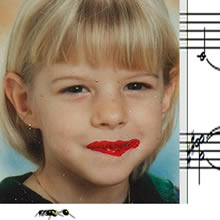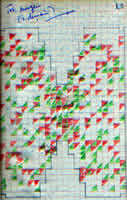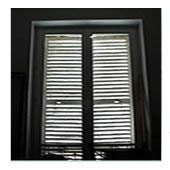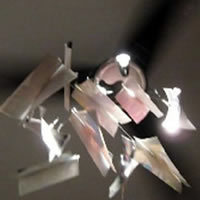
9 min read 🤓
Saskatoon: à demain (tot morgen!) ...
april 22, 2008.
updated: january 29th, 2024
"... tezelfder tijd duizend duivels van beneden
en van boven duizend goden ..."
( * )
Together with three other artists curator Emmanuel Madan invited me to create an unchanging soundscape, for seven consecutive nights in Saskatoon, a city in the Canadian prairie province of Saskatchewan, as part of the month long 4-part Simulcast 1.0b: Saskatoon audio transmission event, an initiative of the Saskatoon media arts production center Paved Arts ...
You can listen to my contribution as a webcast on free103point9, during - and for the exact duration of - every Saskatoon night in the week of april 21st-28th, 2008.
![]() Clicking the 'free103point9.org'-logo to the left, downloads an
m3u file that will automatically launch you into the Simulcast broadcast
stream, but of course that's only during nights in Saskatoon. (The time
difference between Saskatoon and (Central) Europe is 8 hours.)
Clicking the 'free103point9.org'-logo to the left, downloads an
m3u file that will automatically launch you into the Simulcast broadcast
stream, but of course that's only during nights in Saskatoon. (The time
difference between Saskatoon and (Central) Europe is 8 hours.)
Now of course it is only in and near Saskatoon that the transmission will cover all of and precisely the night. When the sun set in Saskatoon, at 20h13 on monday april 21st, over here in Paris (as in Rome, Antwerp, Lommel, Brussels, Leusden, Neerharen, Madrid, Hollum, Amsterdam, Lutjebroek and even in Berlin) the clocks read 4h13 in the morning of tuesday april 22nd. And when a new day dawned in Saskatoon at 5h54, early morning of april 22nd, over here we were somewhere between tuesday's lunch and tea. ( ** )
Unfortunate, really, for those of you who'd like to listen on this here side of the globe.
Tot Morgen (à demain) is very much a 'night piece' ...
At the heart of my 'unchanging_sound-scape' I imagined a
palindromic construct of 'flexible time' to fill the gap between sunset
and sunrise. For it is at night that our no would not ... change ...  You might just keep on switching, from
sunset to rise and then back to sunset again, all within one single night
... and nothing would change ... So, you see ... Saskatoon-nights and the
time to be spanned there had me dreaming. But then when I woke up it
was to just an other morning ...
You might just keep on switching, from
sunset to rise and then back to sunset again, all within one single night
... and nothing would change ... So, you see ... Saskatoon-nights and the
time to be spanned there had me dreaming. But then when I woke up it
was to just an other morning ...
If it were for the palindrome, I might as well have called the piece Tot gisteren (à hier) ... And because I did not (because our time's arrow has one fixed direction), in my 'unchanging soundscape', all Saskatoon-night long, there are * f l i e s *. (You may count them as I slap them, from sunset till sunrise; the time flies tick away your time, 'until, again, the roar of dawn' ... )
It is why Tot Morgen is called Tot morgen (à demain).
It is also why the little girl's picture is its icon
...
The shortest Saskatoon-night in 'my' week is that from sunday April 27th
to monday April 28th. There are 9 hours and 18 minutes between sunset on
the 27th and sunrise the 28th. Tot Morgen's palindrome was made
to fit the length of this shortest one of the seven consecutive nights.
 It has been built with a single chord, that consists in two
tritones that overlap each other by a semitone, and which actually does sound like the buzz
of a nervous gray housefly (musca domestica). I like that chord.
It is the same one ( c - g - f# - c# ) that 'drives' Stockhausen's
Klavierstück IX, where in the first measure it is played 140 times
in an evenly spaced decrescendo that some 50 seconds.
It has been built with a single chord, that consists in two
tritones that overlap each other by a semitone, and which actually does sound like the buzz
of a nervous gray housefly (musca domestica). I like that chord.
It is the same one ( c - g - f# - c# ) that 'drives' Stockhausen's
Klavierstück IX, where in the first measure it is played 140 times
in an evenly spaced decrescendo that some 50 seconds.
Also in Tot Morgen the tritone chord sounds 140 times. Or, to be more precise: it sounds 140 times forwards; and it sounds 140 times backwards.
Click the little drawing to the left: it's a diagram from my notebook, showing
how the 140 forward soundings (represented by the little red triangles)
and the 140 backward soundings (drawn as little green triangles) of the
chord are distributed over the 9 hours and 18 minutes of 'my' shortest Saskatoon-night.
Each square stands for a minute. When you turn the drawing upside down,
what you get is what you had before. But red now is green, and green is
now red: it's a palindrome ...
There are 22 lines in the scheme for 'Tot Morgen', together comprising 558 squares/minutes. Each line - each 'time slot' - contains 12 or 13 triangles. The entry-points of the chords (determining which of the squares will contain a little triangle) were chosen randomly. As you see, lines towards the middle of the diagram become smaller. (Their durations are (in minutes): 29 - 30 - 30 - 30 - 30 - 30 - 30 - 25 - 20 - 15 - 10 , and then back again : 10 - 15, et cetera.) This stepwise contraction dramatically increases the ratio of sound vs. silence when 'Tot Morgen' approaches the 'middle of a Saskatoon-night' ... to then decrease again, onto the dawning of the new day.
'Tot Morgen (à demain)' is a night piece. It draws a bare but predetermined path of
irregular repetitions
of one single sound,
that is stretching out beyond the 'void' of night, way into the next day. A path, identical to its
time-reversal, unfolding forwards exactly the same way as
it does backwards ... Were it not for the flies, it might as well be
time-less ...
 Listen it at night.
Listen it at night.
Listen it alone.
Listen in the dark.
Play it loud, not too loud.
(Adjust the playback volume to make the fly's buzzing sound as if it's there, buzzing around your head.)
Listen it outside, watch the stars.
'Until, again, the roar of dawn'.
Maybe you should drink, like the protagonist in Tip Marugg's De morgen loeit weer aan (The roar of morning).
Or maybe you should not.
But if you do, then take care to stick to whisky or vodka or beer.
It is not a wine-piece.
Or listen it inside.
Lay down ... on a bed, the floor, or a sofa ...
Fold your hands behind your head and watch the ceiling.
Changing patches and patterns of light may come falling through the blinds.
You try to count the flies.
You may fall asleep, until, some time, the sounds wake you.
Continue counting.
You'll fall asleep again.
And so further, and so on.
'Until the roar of dawn' ...
Yeah. See you in the morning, then.
Tomorrow will be different.
...
(added February 1st 2024: the full shortest night version, 9 hours and 18 minutes, is now available for download and streaming on Bandcamp)
[ "pretty lips are red: Time passes, and we pass with it" / « les jolies lèvres ont du rouge : Le temps passe en effet, et nous passons avec lui », cf. down right corner of Guy Debord's Spanish war metagraph, in his Œuvres (Gallimard, 2006) p. 127. ]
...
Here are short descriptions, in reverse chronological order, of the other three contributions to Simulcast 1.0b : Saskatoon, together with the icons that each contributor provided for his or her piece ... [ ^ ]
 Magali Babin, a french
canadian musician, composer and performance artist based primarily in Montreal,
contributed "7 jours sous le Westinghouse" from April 15th till
April 21st. She placed two microphones under a ceiling fan in a room in
her house. "Under the fan," Magali writes, "hangs a mobile composed of photographs
of family members and close friends, illustrating different episodes from
my past. In the foreground of the recording we hear the motor of the Westinghouse
fan as well as the waving of the photos in the wind. In the background,
we can distinguish the ambient sounds of our house at night, as we pass
into sleep and back into wakefulness. Over the seven nights, the only measure
of time is the evolution of the ambient sounds in the background, changing
with the hours of the night and the nights of the week ..."
Magali Babin, a french
canadian musician, composer and performance artist based primarily in Montreal,
contributed "7 jours sous le Westinghouse" from April 15th till
April 21st. She placed two microphones under a ceiling fan in a room in
her house. "Under the fan," Magali writes, "hangs a mobile composed of photographs
of family members and close friends, illustrating different episodes from
my past. In the foreground of the recording we hear the motor of the Westinghouse
fan as well as the waving of the photos in the wind. In the background,
we can distinguish the ambient sounds of our house at night, as we pass
into sleep and back into wakefulness. Over the seven nights, the only measure
of time is the evolution of the ambient sounds in the background, changing
with the hours of the night and the nights of the week ..."
 "Big Time Crash Bang 2008" is the title of the contribution by
GX Jupitter-Larsen, an artist
based in Hollywood, California. In his liner-notes he writes that in the
1980's, in order to create an all-night broadcast using only a single sound,
he would have taken a long tape-loop and played that back through multiple
playback heads. But now, in these digital days, instead of using analog
based repetition, Jupitter-Larsen used a 40 seconds recording of a car accident,
and time-stretched that "into a single ten hour long wave form. The resulting
effect," he observes, "is very much like ceaseless grinding ..." Jupitter-Larsen's
Crash Bang has been grinding ceaselessly every Saskatoon night
between April 7th and 14th from sunset to sunrise.
"Big Time Crash Bang 2008" is the title of the contribution by
GX Jupitter-Larsen, an artist
based in Hollywood, California. In his liner-notes he writes that in the
1980's, in order to create an all-night broadcast using only a single sound,
he would have taken a long tape-loop and played that back through multiple
playback heads. But now, in these digital days, instead of using analog
based repetition, Jupitter-Larsen used a 40 seconds recording of a car accident,
and time-stretched that "into a single ten hour long wave form. The resulting
effect," he observes, "is very much like ceaseless grinding ..." Jupitter-Larsen's
Crash Bang has been grinding ceaselessly every Saskatoon night
between April 7th and 14th from sunset to sunrise.
 In her contribution, Montreal based sound artist Martine H. Crispo used
an unchanging loop of the 60 Hz recorded from an everyday household object.
"The frequency 60 Hz is the soundtrack to the electrical currents that power
our radios, our appliances, our light. Yet," Martine notes, "it is a soundtrack
so prevalent in our everyday lives that only at night in the absence of
noise do we realize that silence is continually filtered through the buzz
and hum of electricity." Martine's DANBY played during the nights
of April 1st-7th.
In her contribution, Montreal based sound artist Martine H. Crispo used
an unchanging loop of the 60 Hz recorded from an everyday household object.
"The frequency 60 Hz is the soundtrack to the electrical currents that power
our radios, our appliances, our light. Yet," Martine notes, "it is a soundtrack
so prevalent in our everyday lives that only at night in the absence of
noise do we realize that silence is continually filtered through the buzz
and hum of electricity." Martine's DANBY played during the nights
of April 1st-7th.
[ ^ ]
notes __ ::
(*) "... a thousand demons from below and from
above a thousand gods ..." is a line from the short novel 'De morgen
loeit weer aan' (1988), by the dutch/antillean writer Tip Marugg (1923-2006).
(There is - or rather has been - an english translation with the
title "The
roar of morning", published by Faber and Faber.) The novel describes
one - the last - night in the life of a solitary protagonist sitting outside
on the steps of his house somewhere on the island of Curaçao,
drinking and thinking, 'until again the roar of dawn' ... It was just after
having 'un-covered' the structural principles of 'Tot Morgen (à demain)'
, when late at night I sat listening to my first attempts at its recording,
that I began to realize how much Tot Morgen - not in the least
because of its flies and the waiting it demands - for
me evoked the atmosphere that I knew so well from Marugg's novel ... With
the chords backwards being his 'thousand demons'; the chords forward are
his 'thousand gods' ... [ ^ ]
(**) Here are the times of sunset and sunrise in Saskatoon for the
week of 21-28 april 2008, and the corresponding times in central Europe :
april 22nd : sunrise 05h54 [ 13h54 ], sunset 20h14 [ 04h14 ]
april 23rd : sunrise 05h52 [ 13h52 ], sunset 20h16 [ 04h16 ]
april 24th : sunrise 05h50 [ 13h50 ], sunset 20h18 [ 04h18 ]
april 25th : sunrise 05h48 [ 13h48 ], sunset 20h19 [ 04h19 ]
april 26th : sunrise 05h45 [ 13h45 ], sunset 20h21 [ 04h21 ]
april 27th : sunrise 05h43 [ 13h43 ], sunset 20h23 [ 04h23 ]
april 28th : sunrise 05h41 [ 13h41 ] ... [ ^ ]
comments for « Saskatoon: à demain (tot morgen!) » ::
|
Comments are disabled |